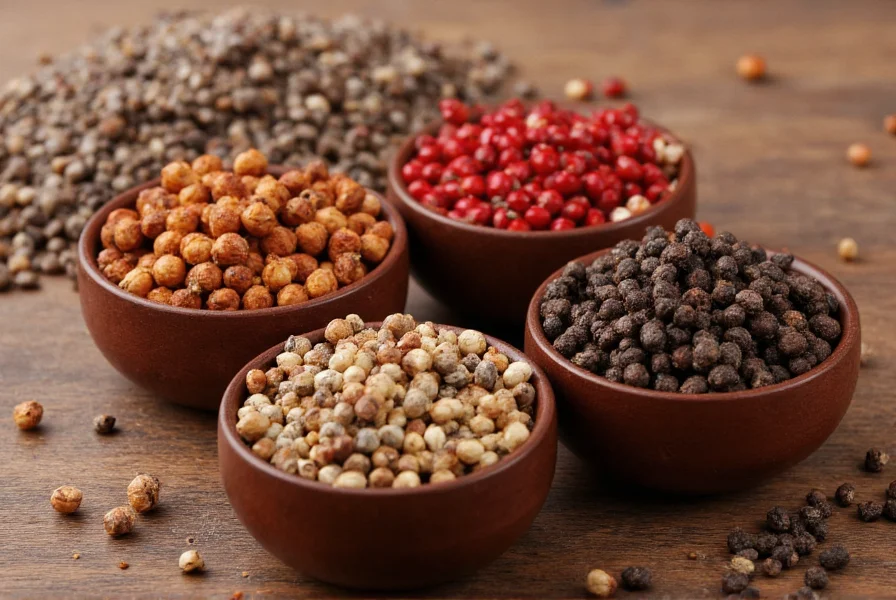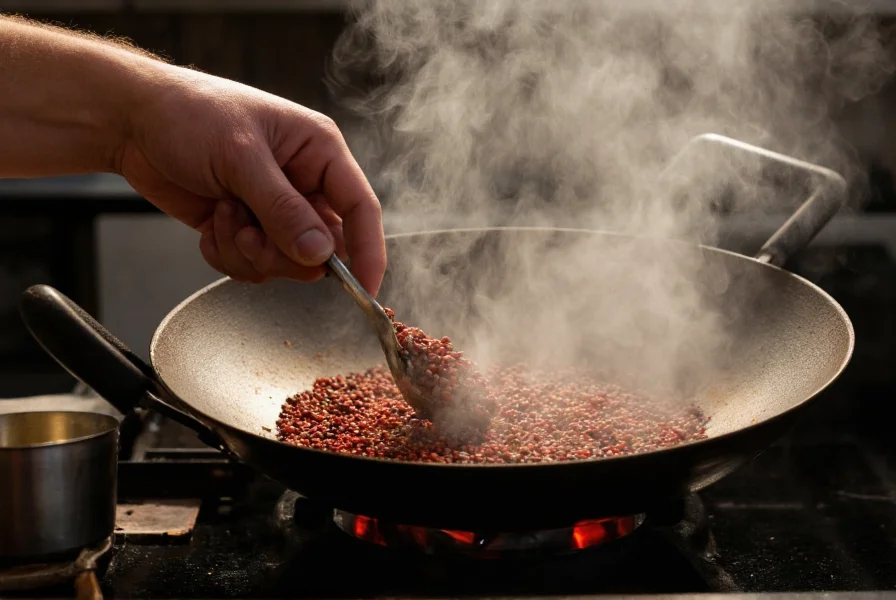If you're looking for a Sichuan pepper substitute, the best alternatives are sansho pepper (for the closest match to the unique numbing sensation), a combination of black pepper and花椒 oil, or Tellicherry peppercorns. For authentic Chinese cooking, sansho pepper provides the most similar mouthfeel, while black pepper with a drop of花椒 oil recreates both heat and aroma. The substitution ratio is typically 1:1 for sansho pepper, but use only half the amount of regular black pepper to avoid overpowering your dish.
Understanding what makes Sichuan pepper unique is crucial when seeking substitutes. Unlike regular black pepper, Sichuan peppercorns (Huājiāo) aren't true peppers but come from the Zanthoxylum genus, producing that distinctive tingling, numbing sensation known as má in Chinese cuisine. This unique property makes finding an exact replacement challenging but not impossible for home cooks and professional chefs alike.
Why Sichuan Pepper Is Different From Regular Pepper
Sichuan pepper's signature numbing effect comes from hydroxy-alpha sanshool, a compound that stimulates nerve endings in your mouth. This creates the tingling sensation essential to authentic Sichuan dishes like mapo tofu and kung pao chicken. Regular black pepper provides heat but lacks this numbing quality, which is why simple pepper substitutions often disappoint.
Top 5 Sichuan Pepper Substitutes Ranked
Not all alternatives work equally well across different recipes. Here's how the most common substitutes compare for various cooking applications:
| Substitute | Best For | Substitution Ratio | Flavor Profile Match |
|---|---|---|---|
| Sansho pepper | Japanese and some Chinese dishes | 1:1 | ★★★★☆ (90% match) |
| Black pepper +花椒 oil | Most Chinese recipes | ½ tsp black pepper + 1 drop花椒 oil per tsp Sichuan pepper | ★★★☆☆ (75% match) |
| Tellicherry peppercorns | Dry rubs and marinades | ½:1 | ★★★☆☆ (70% match) |
| Asafoetida (hing) + black pepper | Vegan and vegetarian dishes | ¼ tsp asafoetida + ½ tsp black pepper per tsp Sichuan pepper | ★★☆☆☆ (60% match) |
| White pepper | Creamy sauces where color matters | ⅓:1 | ★☆☆☆☆ (40% match) |
Sansho Pepper: The Closest Alternative
Sansho pepper, used in Japanese cuisine, comes from a related plant species and provides the most similar numbing sensation. While slightly more floral and less citrusy than authentic Sichuan pepper, it's the best single-ingredient substitute available outside China. When using sansho pepper as a Sichuan peppercorn replacement for ma la sauce, maintain the same quantity specified in your recipe.
Look for green sansho pepper for the freshest flavor, as the numbing compounds degrade over time. Store in an airtight container away from light to preserve potency for up to six months.
Creating a Balanced Substitute With Common Pantry Items
If sansho pepper isn't available, the most effective Sichuan pepper alternative for authentic Chinese cooking combines two ingredients:
- Black Tellicherry peppercorns (coarsely ground) for heat
- 花椒 oil (just a few drops) for the numbing sensation
This combination works particularly well when you need a Sichuan peppercorn substitute ratio that maintains recipe balance. For every teaspoon of Sichuan pepper called for, use half a teaspoon of freshly ground Tellicherry pepper plus one drop of花椒 oil. Add the花椒 oil at the end of cooking to preserve its volatile compounds.
Regional Variations and Special Considerations
The best substitute can vary depending on your specific recipe and regional Chinese cuisine:
- Sichuan cuisine: Prioritize the numbing sensation with sansho pepper or花椒 oil combinations
- Huaiyang cuisine: White pepper works better for delicate dishes where color matters
- Vegan cooking: Asafoetida (hing) with black pepper provides umami depth
- Western adaptations: Tellicherry peppercorns offer familiar heat with complex notes
When substituting in specific dishes like kung pao chicken, remember that Sichuan pepper's numbing quality balances the dish's heat. Without it, the dish may become overwhelmingly spicy. Reduce chili content by 20% when using substitutes that lack the numbing component.
Storage Tips for Maximum Flavor
Whether using authentic Sichuan pepper or substitutes, proper storage maintains potency:
- Store whole peppercorns in airtight containers away from light and moisture
- Grind just before use for maximum flavor release
- Freeze花椒 oil in ice cube trays for portion control
- Label containers with purchase date (peppercorns lose potency after 6-8 months)
For long-term storage of substitutes, consider vacuum sealing sansho pepper or Tellicherry peppercorns with oxygen absorbers. This preserves the volatile compounds responsible for both heat and numbing sensations.
Common Mistakes to Avoid
Many home cooks make these errors when seeking a Sichuan pepper replacement:
- Using equal amounts of black pepper (results in overpowering heat)
- Adding花椒 oil too early in cooking (causes flavor compounds to evaporate)
- Using pre-ground pepper (loses essential oils quickly)
- Ignoring the importance of toasting peppercorns before grinding
For best results when you need what can I use instead of Sichuan pepper, always toast whole peppercorns in a dry pan over medium heat for 1-2 minutes until fragrant before grinding. This releases essential oils that create the complex flavor profile essential to authentic dishes.

When Substitutes Won't Work
Some traditional Sichuan dishes simply require authentic花椒. If you're making:
- Authentic mapo tofu
- Traditional dan dan noodles
- Classic Sichuan hot pot broth
Consider ordering authentic Sichuan peppercorns online rather than substituting. Many Asian grocery websites ship globally, and the unique mouthfeel is integral to these dishes' experience. For occasional cooking, small quantities last months when stored properly.

Can I use regular black pepper as a Sichuan pepper substitute in kung pao chicken?
Yes, but with adjustments. Use only half the amount of freshly ground Tellicherry black pepper compared to Sichuan pepper, and add one drop of花椒 oil per teaspoon of pepper. Without these modifications, regular black pepper will make your kung pao chicken overwhelmingly hot without the characteristic numbing sensation that balances the dish.
What's the difference between Sichuan pepper and sansho pepper?
Both create numbing sensations but have distinct flavor profiles. Sichuan pepper (from Zanthoxylum simulans or Z. bungeanum) has citrusy, floral notes with stronger numbing effects. Sansho pepper (Zanthoxylum piperitum) is milder with more pronounced floral and pine notes. Sansho works as a Sichuan peppercorn replacement for ma la sauce but requires slightly more quantity to achieve similar numbing intensity.
How do I make花椒 oil at home for Sichuan pepper substitution?
To make花椒 oil: Heat ½ cup neutral oil (like canola) over low heat, add 2 tablespoons whole Sichuan peppercorns, and gently warm for 10-15 minutes without boiling. Remove from heat, cool completely, then strain. Store in a dark glass bottle. For substitution purposes, use one drop of this oil plus half the amount of black pepper when replacing Sichuan pepper in recipes.
Why does my Sichuan pepper substitute taste bitter?
Bitterness usually occurs when peppercorns are over-toasted or when using pre-ground pepper that's lost freshness. For best results with Sichuan pepper alternatives, toast whole peppercorns just until fragrant (1-2 minutes), then grind immediately. Never burn peppercorns, as this creates unpleasant bitter compounds. Store substitutes in airtight containers away from light to prevent oxidation that causes bitterness.
Can I use pink peppercorns as a Sichuan pepper substitute?
Pink peppercorns (from the Schinus tree) aren't recommended as Sichuan pepper substitutes. They lack the numbing sensation and have a completely different flavor profile—sweet and floral rather than citrusy and numbing. Some people experience allergic reactions to pink peppercorns, making them unsuitable for reliable substitution in authentic Chinese cooking where the unique Sichuan pepper mouthfeel is essential.











 浙公网安备
33010002000092号
浙公网安备
33010002000092号 浙B2-20120091-4
浙B2-20120091-4